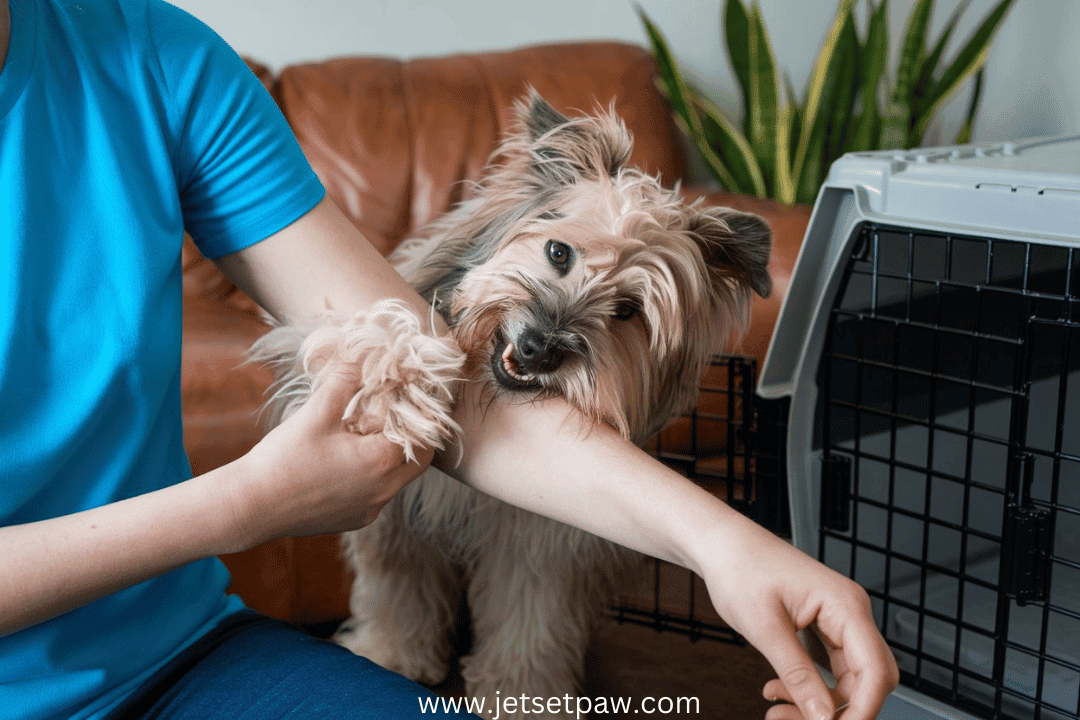Putting your dog in a crate can be an extremely useful training tool that provides them with a safe space of their own.
However, some dogs respond to being created by biting at their owners, which can be surprising and frightening.
This biting behavior usually stems from fear, anxiety, boredom, or lack of proper crate training. While this reaction may seem aggressive, it’s important to understand that biting when created is not an act of true aggression in most cases.
Instead, it’s a stressed response from a dog that dislikes confinement. With patience and proper training methods, you can help your dog learn to feel relaxed and comfortable in their crate over time.
This will eliminate any need for them to bite as you put them into the crate.
Reasons For Crating
Crates can be very useful tools for raising and training dogs when used properly. There are several key reasons why owners may choose to crate their dogs:
1. Housetraining
One of the most common reasons to crate a dog is for housetraining purposes. The crate creates a space where the dog learns to hold their bladder and bowels.
Dogs naturally try to avoid soiling their sleeping area, so they will “hold it” while in the crate. Taking the dog out regularly and praising them for going potty outside reinforces this housetraining. Crates allow owners to gradually teach bladder control.
2. Safety
Crates also provide a safe space for the dog when the owner cannot supervise them. They prevent the dog from getting into things they shouldn’t, such as household chemicals, wires, or fragile objects.
Crates protect dogs from injuring themselves by keeping them confined. Owners can crate their dogs at night or when leaving the home.
3. Travel
Finally, crates enable easy travel with dogs. They allow the dog to be securely and safely transported in vehicles.
Most airlines also require dogs to fly in crates. Crates give dogs a familiar space when away from home. Proper crate training ensures dogs see their crate as a comforting den.
4. Fear and Anxiety
Being confined in a crate can cause some dogs to feel very stressed and anxious. This is especially true for dogs that are not properly crate-trained from a young age.
The small, enclosed space triggers their fear response, making them want to escape. Some signs of anxiety include whining, barking, pacing, trembling, excessive licking, and destructive chewing on the crate.
The dog may even resort to nipping or biting at you when you try to put him in as an act of desperation. He wants to communicate that he is very uncomfortable being confined.
This anxiety often stems from a lack of conditioning to the crate from an early age. Puppies that are gradually introduced to crates with positive reinforcement learn to see it as a safe den.
However, dogs that are simply shoved into crates without this conditioning come to see it as a scary place.
If your dog was not properly crate trained, you will need to work on counterconditioning to build more positive associations.
However, the biting behavior needs to be addressed immediately by never using physical force and ceasing the use of the crate until proper training is complete. Fear and anxiety take patience and compassion to overcome.
5. Boredom
Dogs need mental stimulation and physical exercise every day. If your dog is not getting enough activity, they may act out when confined to their crate due to excess energy and boredom.
Insufficient exercise and stimulation are one of the top reasons dogs try to bite and escape their crate.
Just like humans, dogs need activity and enrichment to be happy and well-behaved. If your dog is constantly crated or left alone without playtime, walks, or toys to keep them occupied, they can become stressed, anxious, and aggressive.
Make sure your dog gets at least 30-60 minutes of exercise and playtime daily. Take them for walks, play fetch or tug of war, or give them chew toys or food puzzle toys.
Providing activities that mentally challenge your dog is just as important as physical exercise. Rotate their toys to keep things interesting.
If your dog has enough stimulation when they’re out of the crate, they’ll be more likely to settle down and relax when confined.
6. Dislike of Confinement
Some dogs have a natural aversion to being confined or closed in. Crates can create a stressful environment by restricting a dog’s movement and freedom.
Certain breeds that were historically given large areas to roam, like Siberian Huskies, may be especially prone to disliking crates.
Dogs that strongly dislike confinement may see a crate as punishing, instead of as a safe space. They feel frustrated, anxious, or trapped when put into a crate.
The crate seems like a cage to them. So when their owner tries to put them inside, they naturally resist and become upset.
Biting or nipping at their owner is a protest behavior expressing their dislike of close confinement.
For some dogs, no amount of training or positive reinforcement can make them accept a crate. Their dislike of confinement is too overpowering.
While crate training can help dogs better tolerate short periods in a crate, some may never view it as a truly safe or relaxing space.
Their personality simply requires more freedom and openness. For these dogs, biting when crated can become an ongoing struggle requiring alternative approaches to confinement when needed.
7. Puppy Biting
It’s very common for puppies to mouth and bite during play or when excited. Puppies explore the world through their mouths and needle-sharp puppy teeth can inflict quite a nip.
Puppies also bite each other when playing—it’s how they learn bite inhibition.
When a puppy nips at you or bites your hand when you reach into the crate, it’s likely playful puppy behavior rather than true aggression. The puppy sees your hand darting in as an invitation to play.
To curb biting during crate time:
- Make sure the puppy gets plenty of playtime and interaction with you outside of the crate. This helps satisfy their need to play and bite.
- Give the puppy something appropriate to chew on in the crate, like a frozen Kong toy. This gives an acceptable outlet for the need to mouth and bite.
- Say “no bite” firmly when nipped and withdraw your hand. Don’t yell or tap the puppy’s nose as punishment.
- If the puppy is very excited when crating, let them calm down before closing the door.
With time, consistency, and maturity, puppies normally outgrow biting when crated. It’s just a passing phase.
8. Pain or Sickness
Dogs may bite out of fear or pain if they are unwell or injured. An illness or injury can cause a dog to feel vulnerable, irritable, and defensive.
They may snap or bite as a reaction if someone tries to touch or move them when they are hurt.
Some common health issues that can cause aggressive reactions in dogs include:
- Arthritis or joint pain – If a dog has sore joints or mobility issues, moving and handling them can be very painful. The dog may bite or growl when touched if they associate it with pain.
- Ear or skin infections – Infections and irritation can make a dog’s ears or skin extremely sensitive. The dog may bite when their ears or body are touched around the infected areas.
- Dental problems like abscessed teeth – An abscess or infection in a dog’s mouth is very painful. A dog with mouth pain may bite when their collar or leash puts pressure on their sore mouth.
- Migraines or neurological issues – Dogs can suffer from headaches and neurological problems just like humans. The symptoms and pain can make them short-tempered and more prone to snapping or biting.
If a dog that is normally friendly or tolerant suddenly becomes reactive or bitey, it’s important to get them checked by a vet.
Treating any underlying physical issue can often resolve the aggressive behavior as well. A dog that no longer feels defensive from pain or illness will be less likely to bite when approached.
9. Poor Crate Training
Rushing the crate training process or not properly acclimating your dog to his crate can lead to fear and anxiety.
Crate training takes patience and should be done gradually over days or weeks. Start with short sessions of only a few minutes with lots of rewards and praise, slowly building up your dog’s duration in the crate while you are home.
Make it a calm, relaxing experience with stuffed Kongs or chews to occupy him. If you immediately lock him for hours, he may panic at being confined and lash out when you open the door.
Go at your dog’s pace and don’t force him to spend long periods in the crate until he has built a positive association. Proper crate training requires time but is essential for your dog to adjust.
Tips to Stop Biting
If your dog tries to bite when being created, there are some positive training techniques you can try to curb the behavior. Being patient and using positive reinforcement is key.
- Reward your dog with treats and praise when he goes in the crate calmly. This teaches him that going in the crate brings good things. Start by rewarding him for just stepping inside, then work up to closing the door.
- Make the crate comfortable. Put a soft bed and some chew toys inside so he enjoys hanging out there. Frozen Kongs stuffed with peanut butter will keep him occupied.
- Set up the crate near family activities and give your dog praise and treats while he’s inside and being calm. This prevents isolation and boredom.
- Never use the crate for punishment. Your dog should see it as a safe den, not a negative place.
- Ignore minor fussing when crating your dog. Reward and let him out when he’s quiet to reinforce calm behavior.
- Exercise your dog before crating. A long walk or play session makes him more likely to settle down.
- Crate train gradually. Short, positive sessions get your dog used to being confined. Reward calmness and slowly increase duration.
With consistency and positive association, your dog can learn to relax in his crate without reacting aggressively. Be patient – this takes time and effort but is worth it.
When to Seek Help
If your dog is biting aggressively when put in his crate, it’s important to seek professional help. Aggressive biting should not be ignored as it can escalate and lead to injuries. Here are some signs that you should seek the advice of a dog trainer or veterinarian:
- Your dog is biting hard enough to break the skin. Any bite that leaves a mark or draws blood needs immediate attention. This shows your dog is using extreme force and is not just mouthing or nipping.
- The bites are accompanied by growling, lunging, or other threatening body language. This demonstrates your dog is acting out of true aggression, not just fear.
- Your dog redirects aggression onto you if you try to remove him from the crate. This shows the behavior is serious enough that he will lash out at anyone when triggered.
- The biting behavior is escalating and happening more frequently or intensely. This signals your dog’s aggression is getting worse over time.
- You have tried training techniques and behavior modification without improvement. Seek advice if gentle, positive reinforcement is not yielding results.
Working with a certified dog trainer or veterinary behaviorist is crucial for curbing aggressive biting.
They can identify the root cause, teach you proper training methods, and potentially prescribe medication if needed.
Don’t try to fix aggressive crate biting entirely on your own, as you may inadvertently make it worse.
Be proactive and seek professional help to get your dog back on track with safe, happy crate habits.

